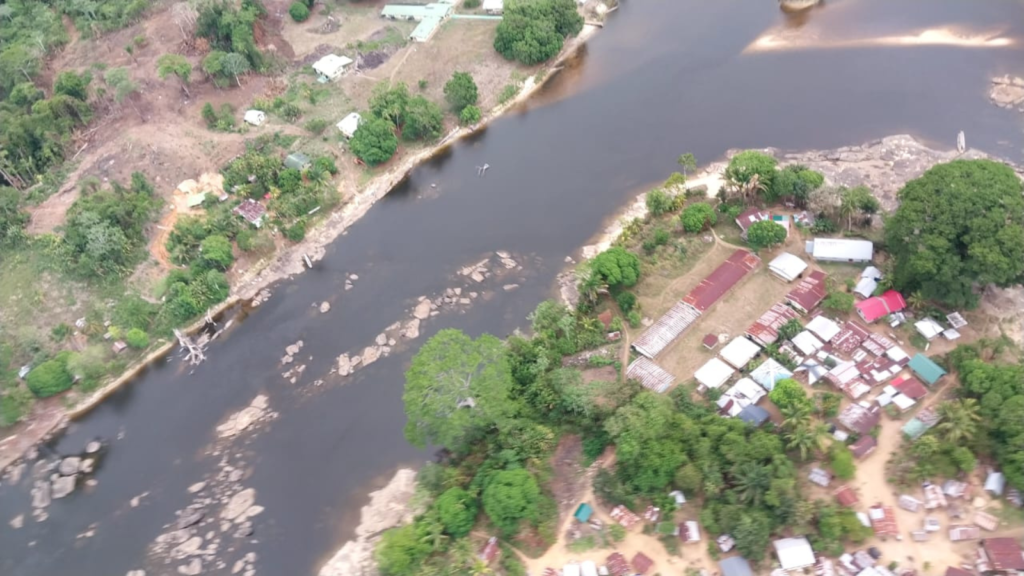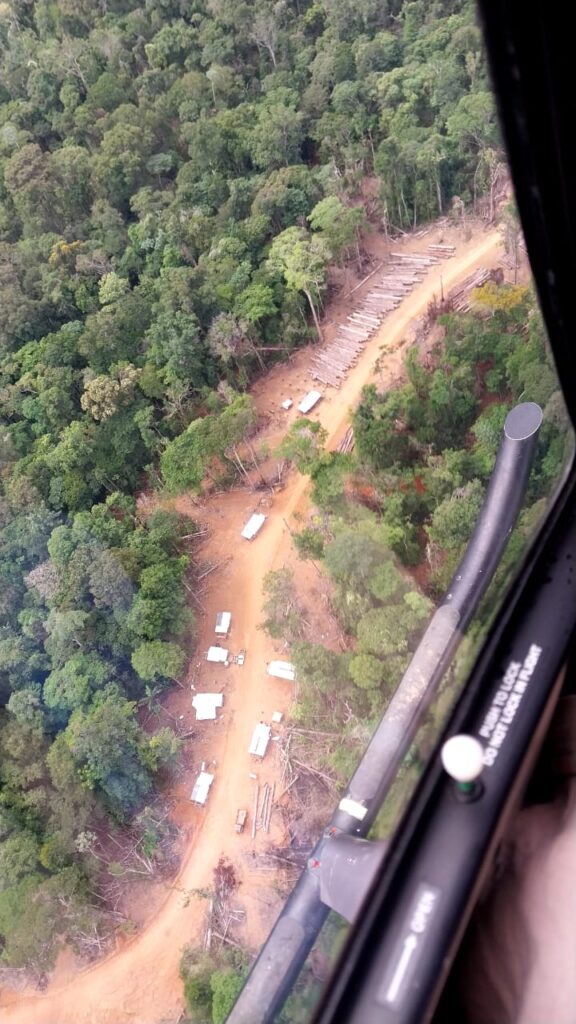The Maroon and Indigenous communities in Suriname are confronting an existential threat from large-scale logging in their habitats. These communities, who rely on the forest for their livelihoods and cultural traditions, are witnessing severe disruptions to their living environment. Despite efforts to defend their rights, the government’s stance has thus far offered no protection.
According to Steven Petrusi, captain of Nieuw Aurora and chairman of the Association of Saamaka Communities (VSG), climate (in)justice occurs daily. The Wayana Indigenous Community has also raised the alarm about deforestation in their regions.
The Saamaka communities are observing a sharp increase in large-scale logging in the hinterland, particularly along the Palmera Road in their territory. During a recent helicopter flight with foreign journalists, Petrusi captured photographs of these destructive activities.
He reports that the community is questioning the allocation of the area and the identity of those responsible for these destructive practices. Beyond the physical destruction of the forest, logging has direct consequences for the food supply and the health of the communities.

Trucks, bulldozers, and machinery pollute the water in creeks with lubricants, which has harmful effects on both the villagers and the local wildlife. The consequences of the disrupted food cycle are already apparent, with animals migrating, fish populations decreasing, and traditional hunting practices becoming increasingly difficult.
The mating season of the animals in the forests is also being disrupted. As a result, hunters in the villages no longer have a clear understanding of how to respond to the seasons that were traditionally known. Traditions are further endangered by large-scale logging and the associated threats. Petrusi highlights examples such as the siksi wiki and the aiti dey following the death of a blood relative. In such cases, the family must enter the forests to fish and hunt, but this entire process is now at risk due to logging. “It is now difficult to walk into the forests to hunt in the village where I live,” he says.
Petrusi is unable to specify the extent of the logging, but it is clear that the deforestation involves hectares of land.
“We really cannot gauge it yet, but we see that it is continuing. We see trucks and machines passing by. So far, we can say that the logging is simply continuing.”
He asserts that the State should be able to establish, by means of a declaration, whether logging has ceased in the area if that were the case. The decision to fly over the Palmera area by helicopter was prompted by signs indicating that the area was off-limits, according to Petrusi.
“We have photos. I have also seen it with my own eyes. The road has been made in our area, and that is where they are extracting timber.” Petrusi emphasises that the Maroon community literally lives off the forest. “We live off creeks. People go into our creeks with trucks, bulldozers, and machines.”
Legal battle for the Amazon Rainforest
The Saamaka communities have not been idle. They have repeatedly sought to attract the attention of the central government. One of their most recent actions was submitting the results of an online petition to the Office of the President. The main concern is the destruction of the forest by the activities of Palmeras Timber N.V., which have far-reaching negative consequences for the Saamaka and the international community. Despite these efforts, the VSG has not yet been heard by the authorities.
The petition called for the accelerated implementation of the Saamaka verdict and an end to concessions granted without the consent of Indigenous and tribal peoples. The aim of this legal battle is not only to preserve their habitat but also to gain international attention and support. The implementation of the Saamaka verdict, a historic ruling that recognises the rights of Indigenous communities, remains largely unfulfilled, leading to growing despair among the Maroon communities.

Arrival of Mennonites
In addition to logging, the Maroon communities are also contending with the arrival of the Mennonites and their large-scale agricultural projects. This project, which aimed to house 50 families and produce crops, has led to legal conflicts and environmental issues. Green NGOs have also opposed the arrival of parties engaged in large-scale logging.
The Mennonite approach is primarily focused on producing soy and maize for export. While these products may become temporarily cheaper, the long-term effects of large-scale agriculture could be detrimental, warns Sleur. These include desertification, land degradation, and disruption of the water cycle. Such changes could lead to even greater water shortages and an increased risk of erosion and mudslides.
President Chandrikapersad Santokhi halted the project in January of this year. This decision was in response to public opposition and revelations of illegal land allocations. A lawsuit filed by a collective of Indigenous communities resulted in a victory for these communities, who objected to the allocation of 35,000 hectares of land under false pretences.
Despite the government’s suspension of the project following public protests and a lawsuit, there are fears that illegal activities may still be taking place. The arrival of the Mennonites underscores a deep-rooted conflict over land rights in Suriname. The government has allocated land to large-scale agricultural projects without the consent of Indigenous and Maroon communities, leading to violations of their land rights and further ecological damage.

Climate change and ecological impacts
The impact of deforestation extends beyond the immediate communities. Environmental activist Erlan Sleur notes that forest destruction contributes to the deterioration of the water cycle, leading to droughts and reduced agricultural productivity. These effects are exacerbated by global climate change, which is already plaguing the region with extreme droughts and water shortages. Although Suriname is internationally known as one of the greenest countries in the world, with an estimated 93% forest cover, Sleur warns that such statements can be misleading.
Satellite data from Global Forest Watch shows a significant decline in forest cover, primarily due to logging and gold mining. In 2023, Suriname lost 26.1 thousand hectares of natural forest, equivalent to 20.4 million tonnes of CO₂ emissions. From 2001 to 2023, Suriname lost 174 thousand hectares of moist primary forests. This type of forest loss accounted for 69% of the total tree cover loss during this period. The total area of moist primary forests in Suriname decreased by 1.4% during this period. These activities not only contribute to the climate crisis but also pose a threat to biodiversity and the survival of local communities.
VSG advisor Hugo Jabini points out that despite claims that Suriname has 93% forest cover, large areas of forest are being cleared. He asserts this based on his observations. A simple drive through the district via the Afobakkaweg serves as silent testimony to the large-scale logging in the areas of the Maroon communities, according to Jabini. He also emphasises that life in these communities has become a living hell for both people and animals due to deforestation.
Sustainable solutions
Despite the challenges, there are alternatives for sustainable development that can help restore balance. Sleur advocates for shifting food production to the coastal plain, where deforested agricultural land is available and less susceptible to drought. This would reduce pressure on forests and promote a sustainable future. Additionally, there are opportunities for sustainable forest management practices, such as agroforestry, which combines agriculture and forest conservation. This approach can help maintain the ecological functions of the forest while still allowing communities to benefit from agricultural activities.
—
This article was originally published by Key News, with the support of the Caribbean Climate Justice Journalism Fellowship, a joint initiative of Climate Tracker and the Open Society Foundations.